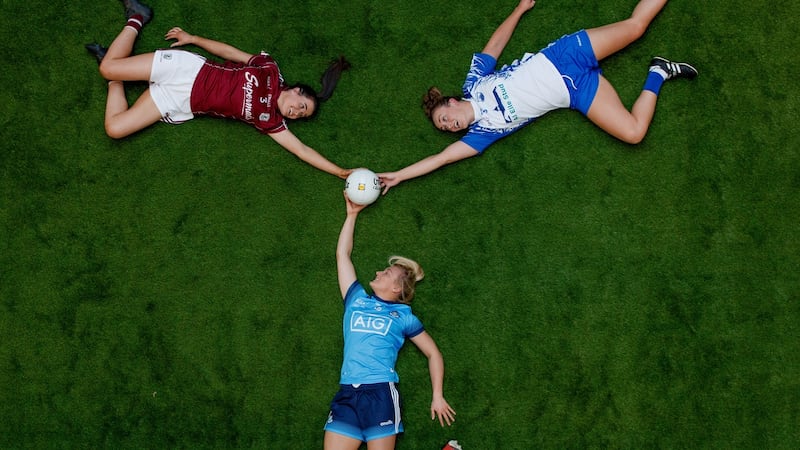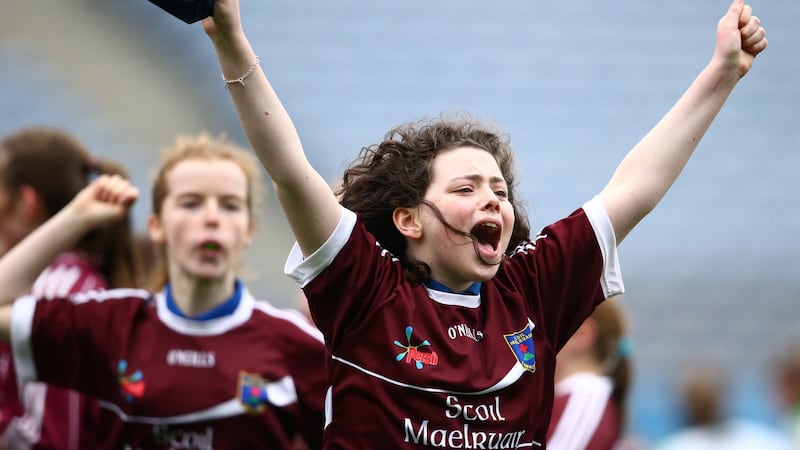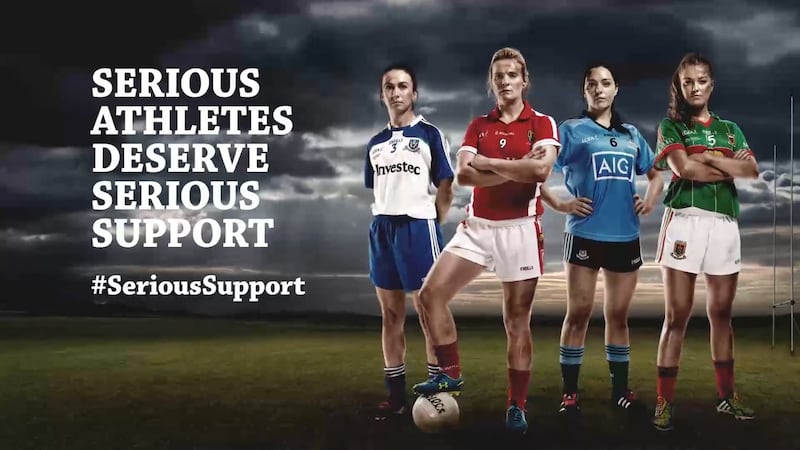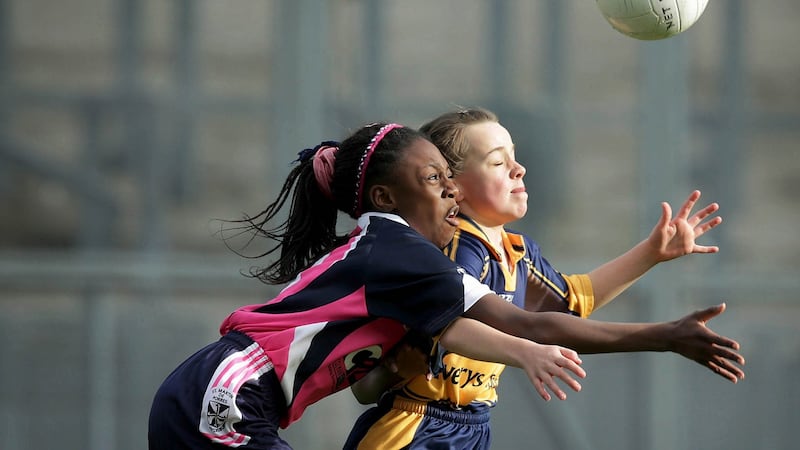The year was 1998 and Helen O'Rourke was sitting across the table from the late Tim O'Connor in RTÉ, putting it up to him. She hadn't been long in the post of chief executive of the Ladies Gaelic Football Association and in all truth, it had been a bit of a dogsbody's gig so far. As the association's first ever paid employee, she found herself on the hook for any and all tasks that were floating around. No job was too small.
This was a big one, though. She knew it. All the plans they had for the LGFA, all the good structural stuff, all the participation targets – all of it was made so much more difficult by the fact that the public was only ever exposed to one women's football match a year. So she was prevailing upon the RTÉ Head of Sport to make the leap and do the right thing – to go one step further and televise the All-Ireland semi-finals as well as the final.
“Everything was such a struggle,” she remembers now. “You were always fighting for coverage. The battle you had to go through to get the semi-finals shown, there just wasn’t the interest there. Tim said to me, ‘The people of Ireland would have more interest in televised tiddlywinks than watching women play football.’
"That's where we were at the time and that's only just over 20-odd years ago. Now, in fairness to Tim, that was his way of going on – the more important point is that he gave us what we asked for. RTÉ did cover the semi-finals and the final and within a couple of years, TG4 saw the potential in it and came on board and that has been a wonderful thing.

“So that was the start of it, really. We always felt we had a great product and a great game and if we could just get it into people’s homes and get people to see it, that it could have a chance to grow. We marked 20 years with TG4 last year. That was the game-changer.”
Last year, there was more women's football in more homes than ever. Much like in the GAA, the pandemic brought about probably a decade's leap in the space of a couple of months. Every inter-county championship game was either shown on TG4 or streamed on Facebook or YouTube. On a local level, club championships at senior and underage got the same treatment.
Women’s football had come full circle. This wasn’t the LGFA banging the table and guilting TV people into covering their games. This was demand from the public leaving the association with no option but to find a way to get these matches broadcast. Unimaginable at the turn of the millennium.
Here's what they were up against. A couple of months after that meeting with RTÉ, a former town commissioner in Roscommon landed himself on the front pages after opposing a £900 grant being issued by the local Vocational Education Committee for the promotion of ladies' football.
"Girls are too precious," harrumphed Malachy Byrne, insisting that it was the fault of sports-mad fathers who didn't have sons pushing their daughters to play sport. "I reckon that a lady or a girl's body is too precious to be abused, bumped and lumped playing football. Their bodies are not made for humps and bumps. They have their own humps and bumps but not to be abused playing soccer and football."
This, to be clear, wasn’t the 1940s or 1950s. This was November 1998. This was four Taoisigh ago. The old goat was carpeted from all quarters and dismissed as a crank but even so, it was telling that the sport could still be framed in this way.
In a single spin of a generation, women’s football has gone from there to here. From tiddlywinks jokes and dinosaurs giving out about grants to being the most played and most watched female team sport in Ireland. Here’s how they did it.
Growth
The fastest growing sport in the country. That was the phrase that was always used. Any time women’s football came up around the turn of the millennium, you could be sure TFGSITC wasn’t too far behind. But speed of growth was never what they were after. No point growing if you can’t sustain it.
By any metric, the past two decades have been an eye-watering success on that score. In 2001, the LGFA had in the region of 80,000 members. By 2020, that number had risen to 192,873. They had around 650 clubs back then; that’s up to 1,395 now and rising all the time. Partly, it was because society was changing. Partly, it was because it was changing society.
"I look back to when I was at school," says Lyn Savage, National Development Manager of the LGFA. "If you had football training at lunchtime, you had a lot of girls who didn't want to come back into class sweaty after training. Some didn't want to come back in without having a shower, some didn't want to shower in a school setting full stop. It all was just off-putting for a lot of girls and not seen as the done thing to do.
“That has changed so much, regardless of the sport. Society is a massive thing. It’s no longer the case that females get looked down on by other females for being into sport or for playing sport. Now it’s far more a case of, ‘Why are you not playing?’ rather than ‘Why would you be doing that?’”
All of which is fine and obviously helpful to the overall effort. But that’s all it is. By itself, it wouldn’t have got them very far at all. It needed them to come up with their own ways of harnessing it and making it a movement.

So they have Gaelic For Girls, aimed at the 8-12 age bracket, girls who missed the nursery stage and don’t like the look of it now because they’re afraid that everyone else will be way ahead of them. And Gaelic For Teens, aimed at keeping the 13-17s playing football. And Gaelic For Mothers And Others, catering for women who don’t need to be dedicating their whole life to the game but would love an hour’s football the odd evening. Club2Gether is aimed at teaching people the structures that go into building a club.
The thrust of each programme is to make football something that is in people’s lives. It exists. You can be part of it. Doesn’t matter who you are, what your skill level, what your athletic ability, the game has a place for you. Everything is planned, focus-grouped, tweaked as they go. Always changing, always learning.
"When we talked about the Gaelic For Teens programme," Savage says, "initially we were thinking we'll get a group of girls and bring them to Croke Park for a day and they'd have a ball and that would be enough to get them playing and maybe even keep some of them playing.
“But then when we sat down with them, they basically said, ‘Well yeah but wait a minute – we could do that ourselves. The reason a lot of us are dropping out is the type of coaching we’re getting.’ So they actually helped us design what has now become Gaelic For Teens. Our engagement now is not necessarily with the teenagers, it’s with the coaches of the teenagers.
“That has been a big part of increasing participation levels, making sure that what we’re trying to offer isn’t just competition. It’s what meets the niche of the people who you’re trying to get involved.”
TG4 partnership
That's the ground war. But again, in and of itself, all that work can only get them so far. In the air, the heft of their sponsors has been crucial. Their partnership with TG4 started in 2000 and the sport is as germane to the station as the station is to the sport. The link-up with Lidl has presented the sport to the public in a way they never imagined before this.
“TG4 was a major turning point in our whole development,” O’Rourke says. “Because all of a sudden parents saw that this was a great game and they wanted to get their daughters involved. In schools, they became more aware of it as well because of TG4 and it appealed to them because here was a game that you could get 15 girls playing. Before that, basketball was traditionally the biggest sport for girls in schools but there’s only five girls on a basketball team. And once it started growing in schools, it was easier to set up underage competitions in every county then as well.
“TG4 were fairly young at the time and we grew together. Because we had television coverage, other sponsors wanted to get involved. When Lidl came along, they didn’t just link up with us, they formed a relationship with TG4, with clubs, with schools, all the way along. Their vision when they started with us was that they would have been perceived as a German company and they wanted to become seen as an Irish company. So they looked at us and saw a ready-made network – we’re in communities, we’re in clubs and so we’re a perfect way in for them.

“From our point of view, we’re able to use the resources they have for things we just couldn’t do ourselves. We could never be in a position to afford what they can put into a marketing budget or to produce the kind of television ads they do. They can promote the game in ways we could never do.”
And so they grew. And they keep growing. O’Rourke was the first ever paid member of staff in 1997; now the LGFA has 15 full-time employees. The average number of clubs per county has gone up from 20 to 43 in the space of two decades. More clubs doesn’t just mean more players. It means deeper connections.
“It’s not long at all since girls in every county had to travel to get involved with a club,” Savage says. “If you weren’t living in one of the big towns, chances were there was no club for you out in your rural village. Identity is so, so important. If you’re having to go and play for a club that you have grown up seeing as the enemy, well then it’s harder for identity to be one of the factors keeping you involved.
“If you’re wearing their tracksuit but your brother is wearing the tracksuit of the club that’s close to your heart, it’s less of a pull for you. Whereas now, there’s hardly a club in the country that doesn’t have a section for girls, a place for them to be included from an early age and for them to be made to feel like they have ownership and identity.”

All the while, the conversations with the GAA about what a meaningful shared future could hold are always ongoing. Time was, O’Rourke would tell anyone who asked that she hoped the LGFA would be affiliated to the GAA as soon as possible. Nobody appears to be in any mad rush on that score right now but there are interesting things happening just the same.
Statistics from the GAA’s Healthy Club Project have shown that about 24 per cent of executive committee roles in GAA clubs were held by women in 2018 and that 66 per cent of clubs have two or more women on their executive. The One Club model whereby GAA clubs cater for women’s football and camogie even though they’re technically part of different associations is becoming the norm in all 32 counties. All children under the age of 12 – boys and girls – are covered by the GAA injury fund.
The game has come a long way. The top players are some of the best known sportswomen in the country, the best and brightest of them flown halfway around the planet to play professionally in Australia. Nobody's making fortunes but they're living lives that would have been unfathomable 20 years ago. The latest Lidl ad shows some of them playing a game on the side of a hill in Glendalough, the none-too-subtle metaphor showing them keeping going despite everything.
“We’ve come a long way but we also know that we’re still on that hill and trying to get further up it,” says O’Rourke. “We’ve made huge strides in terms of funding but it’s always an issue. Government and Sport Ireland have been brilliant over the years and there’s a lot talked about equality. But the funding needed for facilities for women is always going to be needed.
“You look around the country and the game is growing everywhere you look. But we’re all still using the same number of pitches that were there before. Go into any club and there’s the same number of pitches in the vast, vast majority of them as were there 20 years ago. But every club has way more teams and way more players than was the case when those pitches were built. So that’s a big problem that needs to be solved in the coming years. We as a country need to solve it.”
Big problems have never stopped them in the past. No reason to start now.












